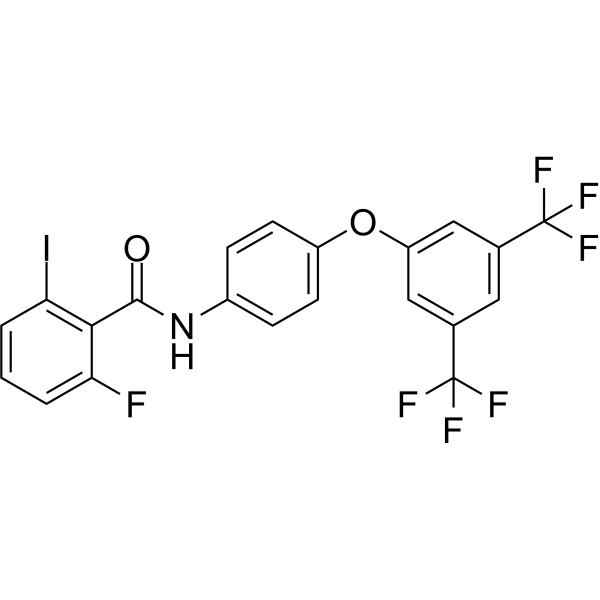
CU-115
CAS No. 2471982-20-2
CU-115 ( N-(4-(3,5-bis(trifluoromethyl)phenoxy)phenyl)-2-fluoro-6-iodobenzamide )
产品货号. M28821 CAS No. 2471982-20-2
CU-115 是 TLR8 的选择性拮抗剂,对 TLR8 和 TLR7 的 IC50 分别为 1.04 μM 和 >50 μM。
纯度: >98% (HPLC)
 COA
COA
 Datasheet
Datasheet
 HNMR
HNMR
 HPLC
HPLC
 MSDS
MSDS
 Handing Instructions
Handing Instructions
| 规格 | 价格/人民币 | 库存 | 数量 |
| 2MG | ¥1482 | 有现货 |


|
| 5MG | ¥3216 | 有现货 |


|
| 10MG | ¥4479 | 有现货 |


|
| 25MG | ¥7233 | 有现货 |


|
| 50MG | ¥9882 | 有现货 |


|
| 100MG | ¥13365 | 有现货 |


|
| 500MG | ¥26568 | 有现货 |


|
| 1G | 获取报价 | 有现货 |


|
生物学信息
-
产品名称CU-115
-
注意事项本公司产品仅用于科研实验,不得用于人体或动物的临床与诊断
-
产品简述CU-115 是 TLR8 的选择性拮抗剂,对 TLR8 和 TLR7 的 IC50 分别为 1.04 μM 和 >50 μM。
-
产品描述CU-115 is a selective antagonist of TLR8 with IC50s of 1.04 μM and >50 μM for TLR8 and TLR7, respectively.(In Vitro):CU-115 (1, 5, and 20 μM) inhibits TLR9 to 10-25% inhibition. CU-115 (5-20 μM) inhibits increases in the activity of type I IFN transcriptional induced by the ssRNA nucleic acid ligands 3p-hpRNA or G3-YSD. CU-115 (5-20 μM) abolishes the TNF-α production activated by R848 (1 μg/ml) and represses the expression of IL-1β in hTHP-1 cells. CU-115 does not modulate the NF-kB inhibition induced by Pam2CSK4, Pam3CSK4, LPS, R848, Poly(I:C), and Flic in HEK-293 TLR1/2, TLR2/6, TLR3, and TLR4 cells.
-
体外实验In endosomal and non-endosomal TLR specificity studies, Human embryonic kidney (HEK) 293 cells expressing human tolllike receptor (hTLR) gene and an inducible secreted embryonic alkaline phosphatase (SEAP) reporter gene were incubated with CU-115 for 16 hours. As a result, CU-115 displays activity for TLR7 and TLR8 at low concentrations (0.5 μM).CU-115 does not modulate the NF-kB inhibition induced by Pam2CSK4, Pam3CSK4, Poly(I:C), LPS, R848, and Flic in HEK-293 TLR1/2, TLR2/6, TLR3, and TLR4 cells. And CU-115 inhibits TLR9 signaling at 1, 5, and 20 μM and ~10-25% inhibition.CU-115 (5-20 μM) inhibits increases in type I IFN transcriptional activity induced by the ssRNA nucleic acid ligands 3p-hpRNA or G3-YSD in a luciferase reporter assay.CU-115 (0.5, 1.0, 5, and 20 μM; 16 hours) is nontoxic at low concentrations (0.5 and 20 μM) and toxic at 100 μM in Hek293 TLR7 and TLR8 cells. CU-115 also is nontoxic at low concentrations (0.5 and 20 μM) and displays partial toxicity at 100 μM in THP Dual cells.The enzyme-linked immunosorbent assay (ELISA) is performed to measure upregulation/inhibition of TNF-α in human THP-1 cells (hTHP-1). CU-115 (5-20 μM)abolishes the TNF-α production activated by R848 (1 μg/ml) in hTHP1. It also represses the expression of IL-1β in hTHP-1 cells. These results suggest that CU-115 suppresses TLR8 and TLR7 signaling pathways.
-
体内实验——
-
同义词N-(4-(3,5-bis(trifluoromethyl)phenoxy)phenyl)-2-fluoro-6-iodobenzamide
-
通路Immunology/Inflammation
-
靶点TLR
-
受体ABHD6
-
研究领域——
-
适应症——
化学信息
-
CAS Number2471982-20-2
-
分子量569.21
-
分子式C21H11F7INO2
-
纯度>98% (HPLC)
-
溶解度In Vitro:?DMSO : 100 mg/mL (175.68 mM)
-
SMILESO=C(NC1=CC=C(OC=2C=C(C=C(C2)C(F)(F)F)C(F)(F)F)C=C1)C=3C(F)=CC=CC3I
-
化学全称——
运输与储存
-
储存条件(-20℃)
-
运输条件With Ice Pack
-
稳定性≥ 2 years
参考文献




-
AG 494
AG-494 是表皮生长因子受体激酶的抑制剂。
-
Rabeximod
Rabeximod is a potent immunomodulator that reduces the severity of autoimmune diseases in rat models. Rabeximod inhibits arthritis in a time-dependent manner by stimulating TLR2 and TLR4 downstream to block the activation of inflammatory cells, most likely macrophages. Rabeximod effectively reduces brain antigen presentation in mice during anti-inflammatory therapy for traumatic brain injury.
-
Imiquimod 2HCl
Imiquimod 2HCl is a toll-like receptor 7 (TLR7) agonist and an immunomodulator with antiviral and antitumor activity.Imiquimod 2HCl can be used to construct a psoriasis-like mouse model, which can be used to study periocular skin cancers, pemphigus foliaceus, and COVID-19 infection.



 021-51111890
021-51111890 购物车(0)
购物车(0)
 sales@molnova.cn
sales@molnova.cn







